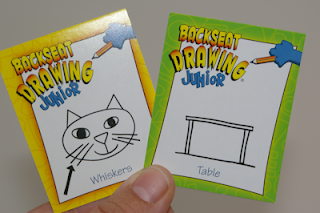 |
Backseat Drawing Junior - Are you really saying what you think you're saying? |
The game consists of cards, white boards, and dry erase markers. The boards measure 8" x 9 3/4" and are a nice quality. They don't smear or leave shadows as long as you clean them off before you put them away. The markers are small but usable. I love the erasers and have taken to carrying them around in my cart for other white board work.
There are 168 cards, printed on both sides, so 336 images total. One side has a green border and is a simpler picture, and the other side has a yellow border and a little more complicated picture (see image below). The cards come in a plastic box with one side cut out so that you can see it without having to remove it (see image above).
The player (Director) will look at his card and, without anyone else seeing it, and give directions for drawing the object to the Artist. The challenge for the Director is to give precise directions so that the Artist will actually end up drawing what is on the card. Players will use a lot of directional and positional words such as left, right, north, south, east, west, diagonal, below, above, next to, inside, around, under, etc. You will find out quickly that instructions such as draw a circle or draw a straight line may be far too vague for the Artist to succeed. Players are not allowed to ask questions and must be able to guess what the object is that the Artist is drawing.
It really is a fun game that will make kids think spatially. I often just use the cards for drawing once kids have graduated from the Ed Emberley step-by-step drawing books. The original Backseat Drawing version, in the red box, offers more advanced play that does not give you a picture to work off of, only a word or two, such as turtle or French fries. Visual memory will be a must with that version.
If you would like to read more about games that require writing or drawing in some form, check out my post Games That Require a Writing Tool.
Object:
Be the first player to earn five points.
Set up:
Place the box of cards in the middle of the players. Use one drawing board as a score board, write each player's name, leaving room for ticks marks. Determine who will be the first Director and who will be the first Artist.
Play:
The Director looks at the card in the box and, without anyone else seeing it, gives the Artist instructions for drawing. The Artists draws what they hear with their board visible to all players. All players except the Director tries to guess what it is the Artist is drawing. Players can make guesses while the Artist is drawing. If someone guesses correctly, that person and the Director each get one point. If the picture is not identified within a few minutes, end that round and start a new one with the next players. The new Director simply removes the card and places it in the back of the box to reveal the new card. The roles of Director and Artist rotate to the left, so that all get turns in each role. Play until someone gets five points and wins the game.
Even though the name is also printed on each card, answers may vary correctly. For example, if rabbit is written on the card but a player says bunny, that is close enough.
Try this:
- Start by drawing a few cards that everyone can see. Demonstrate the importance of clear and accurate directions.
- Allow the use of a ruler for directions such as "draw a 4 inch horizontal line across the middle of the paper".
- Use a white board so that if the instruction is not clear and the person describing can see he led the drawer astray, the drawer can erase and they can try again with new instructions.
- Use just the cards to practice drawing simple objects. Practice proportion, drawing neat closed shapes without overflow, spatial orientation, etc.
- Work on listening, following directions, spatial relations/position in space, visual motor integration, visual discrimination, visual closure, visualization, fine motor precision, using a writing tool, separation of two sides of hand, coordinated use of both hands, manual dexterity, process skills, executive functioning skills, socialization skills, play and leisure exploration and participation


No comments:
Post a Comment
Thank you for taking the time to comment.